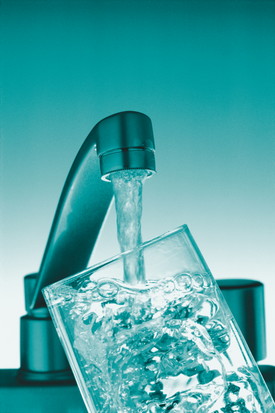Climate change consequences can seem speculative when your wants are met and resources are abundant. But for those living in drought-gripped states, the evils of greenhouse gasses and large carbon footprints are impossible to ignore.
Backyard pools and 10-minute showers are obviously out. But before you don your ceremonial garb and head outside to do a rain dance, follow these four steps to drought-proof your home. Not only will they help you get through the lean days, you’ll be helping prevent future shortages in your city or town.
 Installing a WaterSense aerator will curb water usage from your faucets. |
WaterSense Products
WaterSense has been around for nearly a decade, helping homeowners cut back on water consumption through low-flow toilets, faucets, appliances and other fixtures. Products that carry the WaterSense label require less water to function. A single WaterSense-certified toilet may not make a huge difference, but a household filled with certified products can spell significant water savings.
Such is the power of the WaterSense movement that it has helped save 487 billion gallons of water since its launch in 2006. That’s $8.9 billion saved, and a carbon dioxide reduction of 24 million metric tons. Good for the planet? We think so.
If you’re thinking about investing in WaterSense products and fixtures for your home, be sure to look into available rebates in your state. You can also check with your local water provider for additional information on potential breaks and rebates.
You can save a little extra on plumber’s fees by installing your WaterSense products yourself. Here’s how to:
Curb Usage
Of course the easiest way to reduce water consumption in the home is to do just that: reduce water consumption. We are all guilty at times of lingering in the shower, running the faucet while brushing our teeth and over-rinsing a newly-washing car.
Habits can be hard to break, so consider leaving sticky notes in places to remind you to:
- Stop showering for so long. Set your phone or portable mp3 player to play a 3-minute pop song while you’re in the shower. When the song ends, so does your shower.
- Turn the faucet off when you’re brushing your teeth.
- Don’t run the kitchen faucet while scrubbing your dishes. Fill up one of the sink basins with some soapy water and scrub away on all the dirty dishes. Fill up another with a bit of clean water do a dip-rinse for the scrubbed dishes.
- Think about the old lake-house water closet adage: If it’s yellow, let it mellow. This rule isn’t for everyone, but if you can bear it you WILL save water.
- Turn off the water while you wash and lather your hands.
- Run your dishwasher only when it’s full. If you have a dishwasher (preferably a WaterSense one), use it instead of hand-washing your dishes. Generally speaking, they use less water.
Install a Water Reclamation System
Drought-afflicted areas of the country are likely to be more familiar with water collection systems and greywater reclamation systems for the home. Greywater systems can be designed by re-routing (or having a plumber re-route) your greywater — that is, water from sinks, showers, tubs and washing machines — to your landscape. Fruit trees, vegetables, ornamental plants and other vegetation in the yard can benefit from this irrigation alternative.
Rainwater harvesting systems collect direct rainfall and roof run-off for future irrigation use. Rain barrel installation is quite straightforward (watch the How To here), while other systems simply redirect downspouts towards water-hungry plants and trees. Chew on this: the roof of a 1,000 square foot home can collect almost 600 gallons of water during just one inch of rain. That’s serious water-savings.
 Native plants require less — or no — watering, resulting in water-savings without sacrificing the beauty of your landscaping. |
Ditch Water-Hungry Landscaping
Despite the droughts, there are homeowners who still foolishly carpet their plot with plush, water-needy grass and plants. As municipalities crack down on lawn-watering across drought-affected neighborhoods, the easiest solution is a change of landscaping.
Enter xeriscaping. In simplest terms, xeriscaping is the inclusion of plants and vegetation native to one’s geography. In arid or desert-like cities and towns, this means drought-resistant plants that require very little water to survive. While this solution requires a redefining of beautiful home landscaping, it’s a necessary step to ensure the abundance of this precious resource for future generations.
Get more information on Xeriscaping here:
An Introduction to Xeriscaping
How to Begin Xeriscaping in Your Yard




























